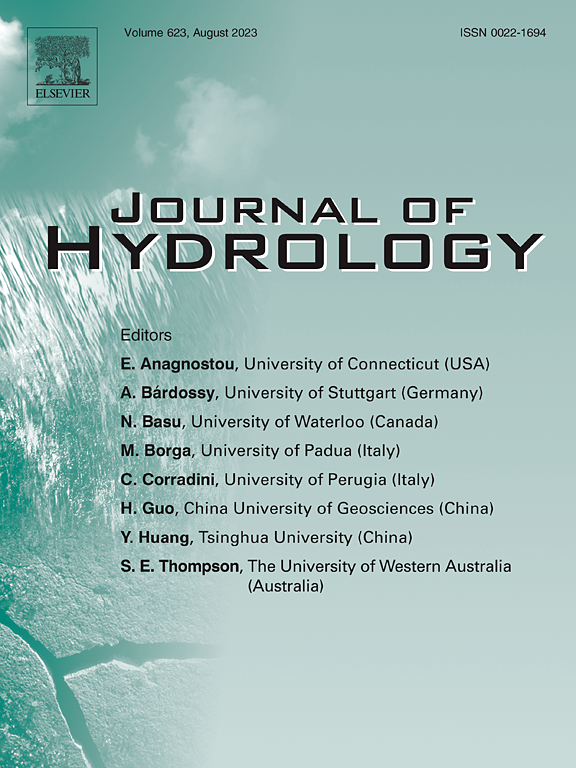农区多频多极化SAR对不同深度土壤水分的敏感性
IF 5.9
1区 地球科学
Q1 ENGINEERING, CIVIL
引用次数: 0
摘要
土壤湿度对作物监测和灌溉管理等各种农业应用至关重要。合成孔径雷达(SAR),特别是在l波段和c波段,已被广泛应用于土壤水分估算。然而,由于SAR信号与地面目标之间复杂的相互作用,土壤水分反演深度的模糊性仍然是一个挑战。本研究定量分析了多频多极化SAR对不同深度土壤水分反演的敏感性。首先,利用Dobson半经验介电混合模型,发现c波段SAR的穿透深度局限于表层土壤表层(0 ~ 5 cm),而l波段SAR的穿透深度可从3 cm到20 cm以上,具体取决于土壤性质。然后,利用原位土壤水分数据对0-5 cm、5 cm、20 cm、50 cm和100 cm 5个深度的土壤水分反演精度进行评价。利用随机森林(RF)回归和极化特征,证明c波段SAR的体积散射是主要的散射机制,导致所有深度的精度降低。相比之下,受水分测量间隔有限的限制,l波段SAR在5厘米深度获得了最高的精度。此外,对入射角和植被覆盖度的分析表明,较低的入射角(15 ~ 45°)和较低的植被条件提高了c波段SAR的精度,而l波段SAR在较浅深度反演土壤水分时对植被覆盖度的敏感性较低。这些研究结果为选择适合农业地区土壤水分反演的SAR数据提供了有价值的见解。本文章由计算机程序翻译,如有差异,请以英文原文为准。
Sensitivity of multi-frequency and multi-polarization SAR to soil moisture at different depths in agricultural regions
Soil moisture is critical for various agricultural applications such as crop monitoring and irrigation management. Synthetic Aperture Radar (SAR), especially at L-band and C-band frequencies, has been widely utilized for soil moisture estimation across different polarizations. However, the ambiguity in the depth of soil moisture retrieval remains a challenge due to the complex interactions between SAR signals and ground targets. In this study, the sensitivity of multi-frequency and multi-polarization SAR to soil moisture retrieval at various depths was quantitatively analysed. First, using the Dobson semi-empirical dielectric mixing model, the penetration depth of C-band SAR was found to be limited to the top surface soil (0–5 cm), while L-band SAR could penetrate from 3 cm to more than 20 cm depending on soil properties. Next, the accuracy of soil moisture retrieved at five depths (0–5 cm, 5 cm, 20 cm, 50 cm, and 100 cm) was evaluated using in-situ soil moisture data. Using Random Forest (RF) regression and polarimetric features, the volume scattering of C-band SAR was demonstrated as the dominant scattering mechanism, leading to reduced accuracy across all depths. In contrast, L-band SAR achieved the highest accuracy at the 5 cm depth, constrained by the limited intervals of moisture measurements. Furthermore, the analysis of incidence angle and vegetation coverage revealed that lower incidence angles (15–45 degrees) and lower vegetation conditions improved the accuracy for C-band SAR. L-band SAR, however, exhibited less sensitivity to vegetation coverage when retrieving soil moisture from shallower depths. These findings provide valuable insights for selecting SAR data suitable for soil moisture retrieval in agricultural regions.
求助全文
通过发布文献求助,成功后即可免费获取论文全文。
去求助
来源期刊

Journal of Hydrology
地学-地球科学综合
CiteScore
11.00
自引率
12.50%
发文量
1309
审稿时长
7.5 months
期刊介绍:
The Journal of Hydrology publishes original research papers and comprehensive reviews in all the subfields of the hydrological sciences including water based management and policy issues that impact on economics and society. These comprise, but are not limited to the physical, chemical, biogeochemical, stochastic and systems aspects of surface and groundwater hydrology, hydrometeorology and hydrogeology. Relevant topics incorporating the insights and methodologies of disciplines such as climatology, water resource systems, hydraulics, agrohydrology, geomorphology, soil science, instrumentation and remote sensing, civil and environmental engineering are included. Social science perspectives on hydrological problems such as resource and ecological economics, environmental sociology, psychology and behavioural science, management and policy analysis are also invited. Multi-and interdisciplinary analyses of hydrological problems are within scope. The science published in the Journal of Hydrology is relevant to catchment scales rather than exclusively to a local scale or site.
 求助内容:
求助内容: 应助结果提醒方式:
应助结果提醒方式:


